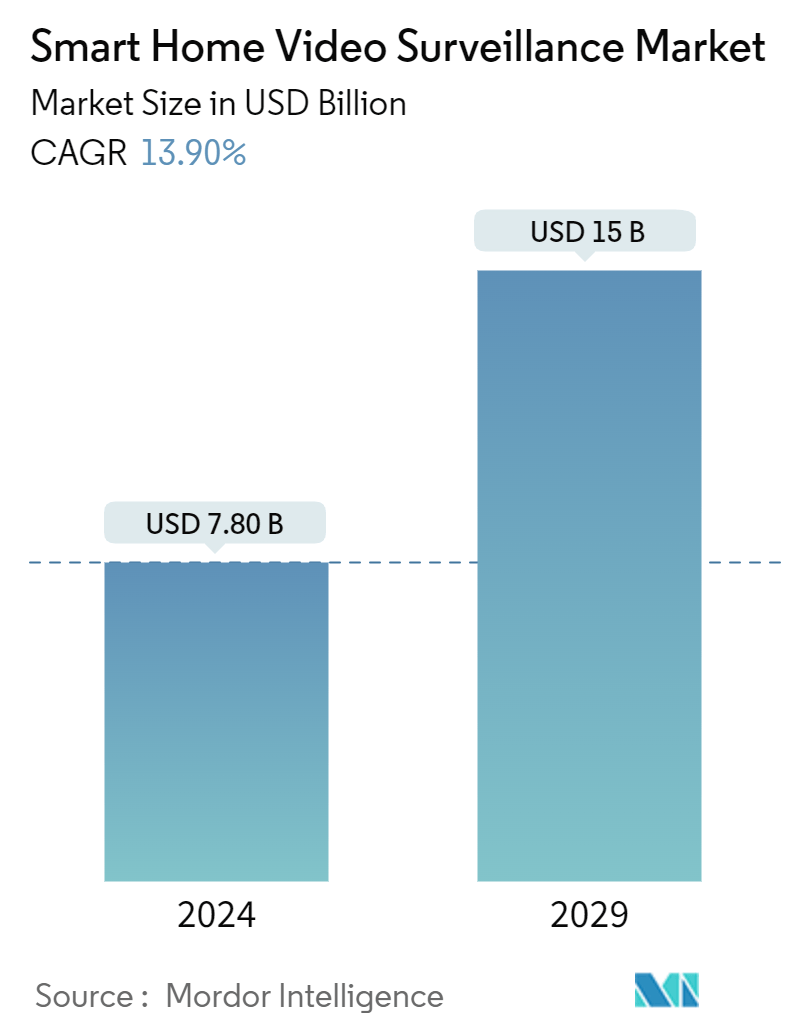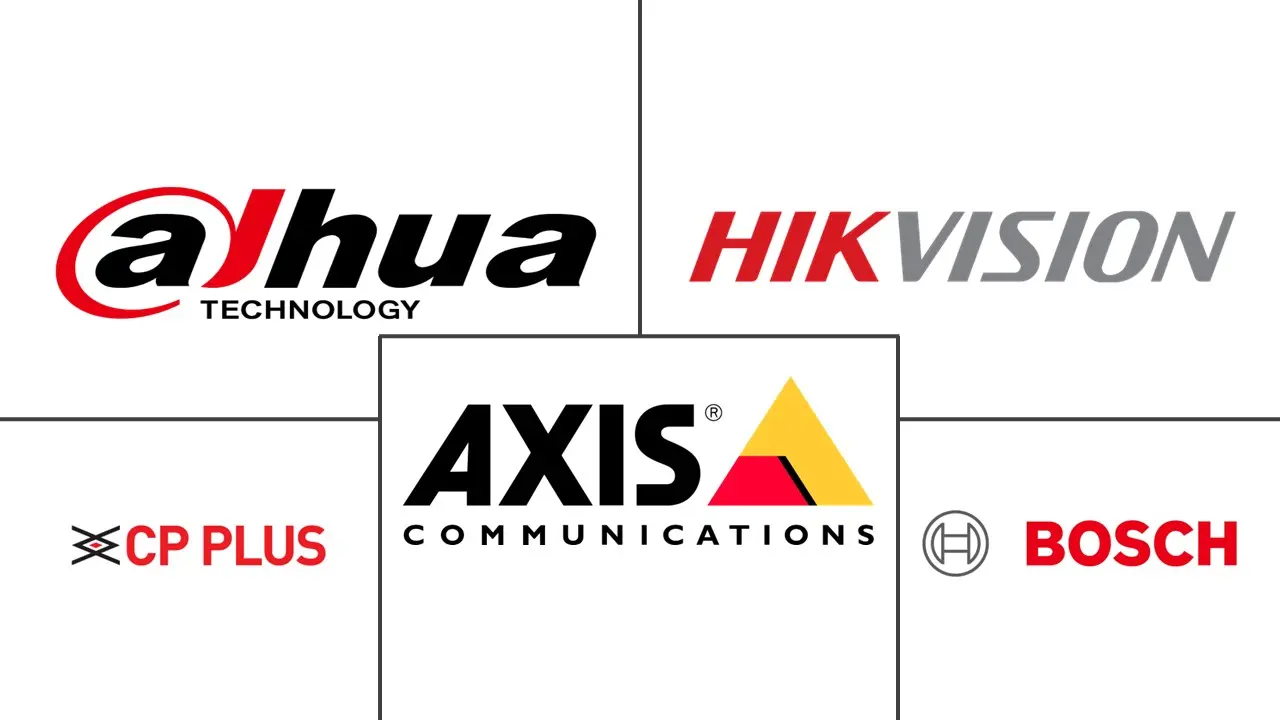Market Size of Smart Home Video Surveillance Industry

| Study Period | 2019 - 2029 |
| Market Size (2024) | USD 7.80 Billion |
| Market Size (2029) | USD 15 Billion |
| CAGR (2024 - 2029) | 13.90 % |
| Fastest Growing Market | Asia Pacific |
| Largest Market | North America |
Major Players
*Disclaimer: Major Players sorted in no particular order |
Smart Home Video Surveillance Market Analysis
The Smart Home Video Surveillance Market size is estimated at USD 7.80 billion in 2024, and is expected to reach USD 15 billion by 2029, growing at a CAGR of 13.90% during the forecast period (2024-2029).
Security always ranks high on homeowners' priority lists. Yet, security threats are evolving as technology becomes more intertwined with daily life. Consequently, the need to invest in robust security systems to safeguard property and loved ones has surged in recent years.
- The rising global instances of thefts and burglaries are a key driver of concerns surrounding home security. The FBI's Uniform Crime Reporting (UCR) Program reveals a stark reality: the United States witnesses an average of 3,062 burglaries daily. This alarming figure underscores the prevalence of home invasions in the nation. Property crimes, encompassing burglary, motor vehicle theft, arson, and larceny-theft, are equally concerning. The FBI notes that in the United States, one of these crimes occurs roughly every 4.4 seconds.
- Urbanization is driving the demand for smart home security solutions, addressing the challenges of high-density living environments. According to the World Bank, 56% of the global population currently resides in urban areas. By 2045, this number is projected to increase by 1.5 times to 6 billion, adding 2 billion more urban residents. As individuals seek enhanced safety and security, the role of smart security devices, which can alert homeowners to potential intrusions, is becoming increasingly significant in the market studied.
- Smart home security cameras, equipped with real-time monitoring and a proven ability to deter intruders, have emerged as a cornerstone in addressing these heightened security concerns. Their visible effectiveness as deterrents has struck a chord with consumers, fueling their widespread adoption. Beyond their role as vigilant sentinels, these cameras offer features remote monitoring and instant alerts, empowering homeowners with a sense of control and awareness, even when they are away.
- Moreover, the video surveillance industry has prominently featured the convergence of security cameras and AI. Notably, in 2023, AI swiftly became the industry's operational norm, witnessing broad acceptance across various sectors. This surge in AI's development has significantly bolstered the appeal of video surveillance, particularly in the smart home segment.
Smart Home Video Surveillance Industry Segmentation
A smart home, as part of the Internet of Things (IoT), leverages internet-connected devices to remotely monitor and manage various systems, from lighting to heating. These systems not only share usage data but also automate actions based on homeowners' preferences. The smart home video surveillance market is defined by the revenue accrued from the sales of different types of video surveillance cameras in the residential sector over various end users across North America, Europe, Asia-Pacific, Latin America, the Middle East, and Africa. The scope includes only the hardware (camera) and service part of the market and excludes the software aspect.
The smart home video surveillance market is segmented by component (cameras, service) and geography (North America, Europe, Asia-Pacific, Latin America, and Middle East & Africa). The market sizes and forecasts are provided in terms of value (USD) for all the above segments.
| By Component | |
| Hardware | |
| Service |
| By Geography*** | |
| North America | |
| Europe | |
| Asia | |
| Australia and New Zealand | |
| Latin America | |
| Middle East and Africa |
Smart Home Video Surveillance Market Size Summary
The smart home video surveillance market is experiencing significant growth, driven by the increasing need for enhanced security solutions in response to evolving security threats. As urbanization continues to rise, the demand for smart home security systems is becoming more pronounced, with homeowners seeking advanced technologies to protect their properties and loved ones. Smart home security cameras, particularly those equipped with real-time monitoring and AI capabilities, are gaining traction due to their effectiveness in deterring intruders and providing homeowners with control and awareness. The shift from traditional analog systems to IP cameras is reshaping the surveillance landscape, offering flexibility, cost efficiency, and advanced features like high-quality image transmission and remote monitoring. This transition is further supported by the integration of cloud-based solutions, which provide convenient access to surveillance footage and real-time alerts.
The market is characterized by a high degree of fragmentation, with numerous vendors such as Axis Communication, Honeywell International Inc., and Panasonic Corporation actively participating. These companies are focusing on product development, strategic partnerships, and acquisitions to expand their market presence. Recent acquisitions, such as Intelligent Monitoring Group Ltd's purchase of Adeva Home Solutions and Resideo Technologies' acquisition of Snap One, highlight the industry's trend towards consolidation and innovation. The Asia-Pacific region, in particular, is witnessing a surge in investments in video surveillance systems, driven by the growing emphasis on security in residential properties. This trend is reflected in the increasing adoption of smart home surveillance technologies, such as doorbell cameras, which are becoming integral to modern security solutions.
Smart Home Video Surveillance Market Size - Table of Contents
-
1. MARKET INSIGHTS
-
1.1 Market Overview
-
1.2 Industry Value Chain Analysis
-
1.3 Industry Attractiveness - Porter's Five Forces Analysis
-
1.3.1 Bargaining Power of Suppliers
-
1.3.2 Bargaining Power of Consumers
-
1.3.3 Threat of New Entrants
-
1.3.4 Threat of Substitute Products
-
1.3.5 Intensity of Competitive Rivalry
-
-
1.4 Impact of Macroeconomic Trends on the Market
-
-
2. MARKET SEGMENTATION
-
2.1 By Component
-
2.1.1 Hardware
-
2.1.2 Service
-
-
2.2 By Geography***
-
2.2.1 North America
-
2.2.2 Europe
-
2.2.3 Asia
-
2.2.4 Australia and New Zealand
-
2.2.5 Latin America
-
2.2.6 Middle East and Africa
-
-
Smart Home Video Surveillance Market Size FAQs
How big is the Smart Home Video Surveillance Market?
The Smart Home Video Surveillance Market size is expected to reach USD 7.80 billion in 2024 and grow at a CAGR of 13.90% to reach USD 15 billion by 2029.
What is the current Smart Home Video Surveillance Market size?
In 2024, the Smart Home Video Surveillance Market size is expected to reach USD 7.80 billion.

